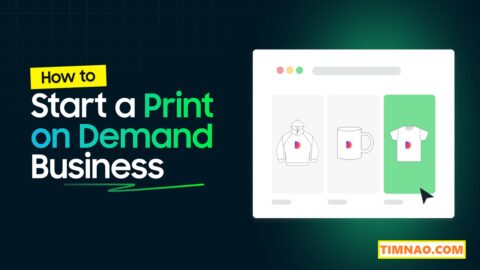Unlock Your Earnings: 6 Awesome Steps to Build Online Blogs and Monetize with AdSense & More Using AI 🚀
Want to build online blogs and turn your passion into profit? You’ve come to the right place! Starting a blog in today’s digital age, especially with the power of Artificial Intelligence (AI), presents an incredible opportunity for aspiring digital entrepreneurs. Even with the rise of video content on platforms like TikTok, the appetite for well-written, informative blog posts remains strong. People still love to read, learn, and engage with quality content online.
This guide will walk you through how to build online blogs from scratch and explore various strategies to monetize your blog, focusing heavily on Google AdSense monetization but also covering other lucrative avenues like affiliate marketing, sponsored posts, and selling your own products. We’ll leverage the magic of AI to streamline content creation, optimize for search engines, and manage your burgeoning online presence efficiently. Get ready to learn how to make money blogging!
The Massive Opportunity in Blogging & Display Ads 💰
Think blogging is dead? Think again! Just like the book market continues to thrive, the world of online blogs is expanding, and so is the lucrative market for display advertising. The global advertising technology (Adtech) market, which includes display ads you see on websites, was valued impressively in recent years and is projected to grow significantly. Some reports estimate the market reaching over $1.5 trillion by 2030, with a compound annual growth rate (CAGR) potentially exceeding 14% or even higher in specific segments like Adtech services.
What does this mean for you? If you monetize your blog with display advertising (like Google AdSense), you earn money when ads are shown on your site. This is often measured in CPM (Cost Per Mille, or Cost Per Thousand Impressions). While rates vary wildly based on niche, audience location, and ad quality, even a modest CPM can add up. The document suggested $0.50-$1 CPM leading to $500/month for 50,000 views, but realistically, CPMs for targeted niches can be significantly higher, especially with premium ad networks. Building a successful blog with substantial traffic can absolutely generate significant income through Google AdSense monetization and other methods.
The AI-Powered Blogging Business Model 🤖
So, how do we efficiently build online blogs and monetize them? The modern approach involves integrating AI tools into the workflow. AI chatbots like ChatGPT, Google Gemini, or Claude, along with specialized AI writing assistants like Jasper or Surfer SEO, can dramatically simplify the process.
Here’s the core idea:
- Use AI for Content: Generate ideas, draft articles, create outlines, and even help optimize content for search engines (SEO).
- Use AI for Management: Leverage AI for tasks like social media scheduling and analyzing performance data.
- Monetize Strategically: Implement Google AdSense monetization, join affiliate programs, partner with brands for sponsored posts, and potentially sell your own digital or physical products.
By automating many time-consuming tasks, AI allows you to focus on high-level strategy, audience engagement, and scaling your blogging empire. It helps you create better content faster, reach a wider audience, and ultimately, make money blogging more effectively in a competitive landscape.
Your Step-by-Step Blueprint to Building and Monetizing Your AI Blog ✨
Let’s break down the process into actionable steps.
Step 1: Choose Your Profitable Niche Wisely 🎯
Before you write a single word, you need to decide what you’ll write about. This is your niche. Choosing the right niche is crucial to build online blogs successfully. You want a topic that:
- Interests You: You’ll be creating a lot of content, so genuine interest helps maintain motivation.
- Has Audience Demand: Are people actually searching for information on this topic?
- Has Monetization Potential: Can you realistically monetize this blog niche through ads, affiliate products, etc.?
- Isn’t Overly Saturated: While competition exists everywhere, finding a sub-niche or unique angle can help you stand out.
How to Find Your Niche:
- Brainstorm: List your hobbies, skills, passions, and areas of expertise.
- Market Research: Use tools like Google Trends to see what topics are popular. Explore online forums (like Reddit or Quora) and social media groups to see what questions people are asking.
- Keyword Research: Tools like SEMrush, Ahrefs, Google Keyword Planner (free with a Google Ads account), or even lower-cost options like Keysearch can reveal search volume (how many people search for a term) and keyword difficulty (how hard it is to rank for that term). Look for keywords with decent volume but lower difficulty, especially when starting.
- Competitor Analysis: Look at existing blogs in potential niches. What are they doing well? Where are the gaps you could fill? Can you offer a unique perspective or go deeper on specific topics?
Focus Keyword Placement: Ensure your primary focus keywords (like “build online blog” or “monetize blog“) are relevant to the niche you choose, if applicable, or become the central theme of your blog if you’re teaching others how to blog.
Step 2: Set Up Your Blog’s Foundation 🏗️
Once you have a niche, it’s time to build your digital home. This involves a few key technical decisions:
- Domain Name: This is your blog’s address (e.g.,
yourblogname.com). Choose something memorable, relevant to your niche, and preferably ending in.com. You can register domains through registrars like Namecheap or often get one free for the first year with a hosting plan. - Web Hosting: This is where your website files live so people can access them online. For beginners, shared hosting is usually the most affordable starting point. Popular and reliable providers mentioned in the source material and found in searches include:
- SiteGround
- Bluehost
- Hostinger
- DreamHost
- A2 Hosting
- 10Web (offers managed WordPress hosting on Google Cloud) Choose a provider known for good uptime, speed, customer support, and features suitable for your budget. Initial shared hosting often costs around $3-$10 per month (often billed annually for the best rate).
- Blogging Platform (CMS): This is the software you’ll use to create and manage your content. The undisputed king is WordPress.org (the self-hosted version, not WordPress.com). It’s free, incredibly flexible, powerful, SEO-friendly, and has a massive ecosystem of themes (designs) and plugins (add-on features). Other options exist like Wix, Squarespace, Ghost, or Joomla, but WordPress offers the best long-term scalability and control for serious bloggers aiming to monetize blog content effectively.
- Theme: Choose a design (theme) for your WordPress blog. There are thousands of free themes available, and premium themes offer more features and support. Focus on a theme that is clean, fast-loading, mobile-responsive, and fits your niche’s aesthetic. Kadence is mentioned as a good free option.
- Essential Plugins: Install a few key WordPress plugins:
- SEO Plugin: Yoast SEO or Rank Math are essential for optimizing your content (titles, descriptions, keywords).
- Caching Plugin: To speed up your site (often provided or recommended by your host).
- Security Plugin: To protect your site from threats.
- Contact Form Plugin: For readers to get in touch.
Focus Keyword Placement: If your blog is about blogging, naturally weave terms like “build online blog” into your “About” page or introductory posts.
Step 3: Create Amazing Content with AI Assistance ✍️ + 🤖
Content is the heart of your blog. This is where AI truly shines in helping you build online blogs efficiently. Remember, AI should be your assistant, not a complete replacement for your unique voice and expertise.
AI Blogging Workflow:
- Topic Ideation: Use tools like ChatGPT, Gemini, or Claude to brainstorm blog post ideas based on your niche and target keywords. Ask for outlines, different angles, or questions your audience might have. (See PDF prompts for examples).
- Drafting: Let AI writing assistants like Jasper or the chatbots mentioned above generate initial drafts. Provide clear prompts, specify the target audience, desired tone, and keywords.
- Human Refinement: Crucially, always edit, fact-check, and refine the AI-generated content. Add your personal insights, experiences, stories, and unique voice. Ensure accuracy, improve flow, and make it engaging. Google values high-quality, helpful content created for humans – pure, unedited AI output often lacks depth and authenticity.
- SEO Optimization: Use your SEO plugin (Yoast SEO, Rank Math) to optimize each post. This includes:
- Focus Keyword: Defining the main keyword for the post.
- Title Tag: Crafting a compelling headline including the keyword.
- Meta Description: Writing an enticing summary (appears in search results) with the keyword.
- Headings (H2, H3, etc.): Structuring your content logically with headings that include keywords naturally.
- Image Alt Text: Describing images for search engines and accessibility.
- Internal Linking: Linking to other relevant posts on your blog.
- Readability: Ensuring your content is easy to read and understand. Tools like Surfer SEO or Frase can provide more advanced content optimization suggestions based on top-ranking competitors.
- Visuals: Enhance your posts with relevant images or videos. Use high-quality stock photos (like Unsplash, Pexels) or create custom graphics using tools like Canva. AI image generation tools like DALL-E 3 or Midjourney (often accessed via Discord) can also create unique visuals, but ensure you understand their terms of use.
Consistency is Key: Aim for a regular publishing schedule (e.g., 1-3 posts per week) to keep your audience engaged and signal to search engines that your site is active. Quality always trumps quantity, but consistent quality is the goal.
Focus Keyword Placement: Naturally incorporate your focus keywords like “build online blog,” “monetize blog,” “AI blogging,” and “Google AdSense monetization” within your article titles, headings, introduction, conclusion, and throughout the body text where it makes sense. Don’t stuff keywords unnaturally!
Step 4: Monetize Your Blog – Turning Traffic into Income 💸
Once you start getting traffic (visitors) to your blog, it’s time to monetize your blog. Here are the most common and effective strategies, often used in combination:
-
Display Advertising (Google AdSense & Alternatives) 🖼️: This is often the first monetization method bloggers explore.
- Google AdSense: The most popular platform. You sign up, add a code snippet to your site, and Google automatically displays relevant ads. You earn money based on impressions (views) or clicks (CPC – Cost Per Click). It’s relatively easy to set up, but earnings depend heavily on traffic volume, niche, audience demographics, and ad placement. Keep up with AdSense policies to ensure compliance. Recent updates include changes to the policy center for better issue understanding.
- Premium Ad Networks: Once your traffic grows significantly (e.g., 50,000+ monthly sessions), you can apply to premium networks like Mediavine or AdThrive. These networks typically offer much higher CPMs and better ad quality than AdSense but have stricter requirements (traffic minimums, original long-form content, good standing with AdSense). Casey’s case study in the document highlights reaching Mediavine levels.
- Ad Placement: Experiment with ad placements (sidebar, within content, header, footer) but prioritize user experience. Too many intrusive ads can drive readers away.
-
Affiliate Marketing 🤝: Promote other companies’ products or services and earn a commission for every sale made through your unique affiliate link.1
- Find Programs: Join affiliate networks like Amazon Associates (huge range of products, lower commissions), Commission Junction (CJ), ShareASale, ClickBank, or look for independent affiliate programs related to your niche (e.g., software, courses, physical products).
- Promote Naturally: Integrate affiliate links seamlessly within your content. Write honest reviews, tutorials, or comparison posts featuring the products. Only recommend products you trust and that genuinely benefit your audience. Disclose your affiliate relationships clearly (often required by law and good practice).
- Tools: Plugins like Lasso or ThirstyAffiliates can help manage your affiliate links.
-
Sponsored Content & Brand Partnerships 📢: Brands pay you to write a dedicated post, review, or social media mention featuring their product or service.
- Build Authority: This works best once you have an established audience and authority in your niche.
- Outreach: You can reach out to relevant brands directly or use platforms that connect bloggers with brands (like BuzzStream mentioned in the document, or others like Izea or AspireIQ).
- Transparency: Always clearly disclose sponsored content to your audience to maintain trust. Ensure partnerships align with your blog’s values.
-
Selling Your Own Products or Services 🛍️: This can be highly profitable as you keep 100% of the revenue (minus processing fees).
- Digital Products: Ebooks, online courses, workshops, printables, templates, stock photos. These are scalable and have low overhead. Platforms like Teachable, Podia, or WooCommerce (for WordPress) can help.
- Physical Products: Merchandise (T-shirts, mugs), handmade goods, books. Requires inventory management and shipping.
- Services: Coaching, consulting, freelance writing, web design (if relevant to your niche).
-
Other Strategies:
- Memberships/Subscriptions: Offer exclusive content, community access, or perks for paying members (using plugins like MemberPress or Patreon).
- Donations: Accept donations via platforms like PayPal or Buy Me a Coffee if your audience finds your content valuable.
Focus Keyword Placement: Write specific posts about “how to monetize blog” or “Google AdSense monetization tips” if your blog focuses on blogging itself.
Step 5: Promote Your Blog Like a Pro 📣
Creating great content isn’t enough; you need to get eyes on it! Promotion is key to driving traffic so you can monetize your blog.
- Search Engine Optimization (SEO): This is fundamental. Optimizing your content (Step 3) helps people find your blog via search engines like Google. It’s a long-term strategy but drives highly targeted, organic traffic. Focus on creating helpful content that answers user questions and naturally incorporates relevant keywords. Build high-quality backlinks (links from other reputable websites to yours) over time – this signals authority to Google.
- Social Media Marketing: Share your blog posts on relevant social media platforms (Facebook, Instagram, Pinterest, LinkedIn, X, TikTok, etc.).
- Choose Platforms Wisely: Focus on where your target audience hangs out.
- Engage: Don’t just broadcast links; interact with followers, join conversations, and build a community.
- Visuals: Use compelling images or videos with your posts.
- Tools: Social media management tools like Buffer, Hootsuite, Social Pilot, or Sprout Social can help schedule posts and analyze performance across multiple platforms. AI can assist in crafting social media updates based on your blog posts.
- Email Marketing: Build an email list and nurture relationships with your subscribers. This is one of the most valuable assets for long-term blog monetization.
- Offer an Incentive: Provide a reason for people to subscribe (e.g., a free checklist, ebook, mini-course – called a lead magnet).
- Use an Email Service Provider (ESP): Services like Mailchimp, ConvertKit (popular with bloggers), MailerLite, or ActiveCampaign help you manage subscribers, send newsletters, and automate email sequences.
- Provide Value: Send regular newsletters with your latest posts, exclusive tips, or insights. Don’t just sell constantly.
- Segment: Tailor emails based on subscriber interests for better engagement.
- Community Building: Engage with readers in your blog comments, create a Facebook group, or participate in relevant online communities and forums (without spamming).
- Networking & Outreach: Connect with other bloggers in your niche for potential collaborations, guest posting opportunities, or cross-promotion.
- Content Repurposing: Turn blog posts into videos, infographics, podcast episodes, or social media threads to reach a wider audience.
Step 6: Analyze, Optimize, and Adapt 📊
To build online blogs that succeed long-term, you need to understand what’s working and what’s not. Data analysis is crucial.
- Google Analytics: This free tool (Google Analytics) is essential. Set it up early to track:
- Traffic: How many people visit your site (Users, Sessions, Pageviews).
- Traffic Sources: Where visitors come from (Organic Search, Social, Direct, Referral).
- Top Content: Which posts are most popular.
- Audience Demographics: Information about your visitors (if available).
- Engagement Metrics: Bounce Rate, Average Session Duration, Pages per Session.
- Google Search Console: Another free tool from Google. It shows how your site performs in Google Search, which keywords drive traffic, any technical errors, and allows you to submit sitemaps.
- Ad Network Dashboards: Monitor your earnings, CPMs, and ad performance within your AdSense or premium ad network dashboard.
- Affiliate Network Dashboards: Track clicks, conversions, and commissions for your affiliate promotions.
- Behavior Analytics Tools: Tools like Hotjar provide heatmaps (showing where users click and scroll) and session recordings (watching anonymous user journeys) to understand how people interact with your site and identify usability issues.
- Key Performance Indicators (KPIs): Track the metrics that matter most for your goals:
- Revenue (AdSense, Affiliate, Product Sales)
- Traffic (Sessions, Unique Visitors)
- Engagement (Time on Page, Bounce Rate)
- Ad CTR (Click-Through Rate)
- Affiliate Conversion Rate
- Email List Growth Rate & Open/Click Rates
Use these insights to:
- Identify your most popular content topics and formats.
- Understand which promotion channels drive the most valuable traffic.
- Optimize underperforming posts.
- Improve site navigation and user experience.
- Refine your monetization strategies.
- Adapt to changing trends and algorithm updates.
AI Blogging Angle: AI tools can also assist in analyzing data and generating reports, helping you make sense of the numbers faster.
Pros and Cons of AI-Powered Blogging ⚖️
Leveraging AI to build online blogs offers significant advantages, but it’s not without challenges.
Pros:
- ✅ Efficiency & Speed: AI drastically speeds up content creation, research, and some management tasks.
- ✅ Scalability: Easier to produce more content and potentially manage multiple blogs.
- ✅ Lower Initial Barrier (Potentially): Can help overcome writer’s block and generate initial content faster.
- ✅ Diverse Revenue Streams: Blogging itself allows for multiple income streams (ads, affiliate, products, etc.).
- ✅ Low Startup Costs: Relatively inexpensive compared to brick-and-mortar businesses (hosting, domain, some tools).
- ✅ Creative Freedom & Branding: Build a platform around your passions and establish yourself as an expert.
Cons:
- ❌ Time Investment: Despite AI, building a successful blog still takes significant time and consistent effort, especially initially, to gain traction.
- ❌ Quality Control: Over-reliance on AI without human oversight can lead to generic, inaccurate, or low-quality content that won’t rank well or engage readers. Requires careful editing.
- ❌ SEO Complexity: SEO is constantly evolving. Keeping up with best practices and technical aspects requires ongoing learning.
- ❌ Income Variability: Blog income can fluctuate based on traffic, algorithm changes, seasonality, and ad market shifts. It’s often not a get-rich-quick scheme.
- ❌ High Competition: The blogging world is crowded. Standing out requires high-quality, unique content and smart marketing.
- ❌ Platform Dependence: Revenue often relies on third-party platforms (Google AdSense, Amazon Associates, Social Media). Changes in their policies or algorithms can impact your earnings.
- ❌ Authenticity Challenge: Ensuring AI-assisted content retains a genuine, human voice requires skill.
What Does It Really Cost to Start? 💲
Starting a blog can be incredibly affordable. The PDF and recent articles suggest:
- Domain Name: ~$10-20 per year (often free for the first year with hosting).
- Web Hosting: ~$3-$10+ per month for basic shared hosting (paid annually often cheaper). ~$36-$120+ per year.
- Blogging Platform: WordPress.org is free.
- Theme: Free options available, premium themes ~$50-$100 (one-time or annual).
- Essential Plugins: Many essential functions (SEO, security basics) have free versions.
Bare Minimum Startup (First Year): You could realistically start for under $100 for the first year if you use free themes/plugins and get a free domain with hosting.
Optional/Growth Costs:
- AI Writing Tools: ChatGPT Plus (~$20/month), Jasper (~$40+/month), Claude Pro (~$20/month).
- SEO Tools: Ahrefs/SEMrush ($100+/month – often overkill for beginners), Keysearch (~$17/month), Surfer SEO (~$60+/month).
- Email Marketing: Mailchimp/ConvertKit (free tiers available, paid plans ~$10-$30+/month depending on subscribers).
- Premium Theme/Plugins: Varies.
- Stock Photos/Graphics: Canva Pro (~$13/month).
You can start lean and invest in premium tools as your blog grows and generates revenue.
Skills You’ll Need (Or Develop!) 🛠️
Successfully building and monetizing a blog requires a blend of skills:
- Content Creation: Ability to write (or effectively edit AI-generated) engaging, valuable content.
- SEO Knowledge: Understanding keyword research, on-page optimization, and basic link-building concepts.
- Technical Basics: Comfort with using WordPress, installing themes/plugins, and basic website maintenance.
- Digital Marketing: Promoting your blog via social media, email, etc.
- AI Tool Proficiency: Learning how to effectively prompt and utilize AI writing and image tools.
- Data Analysis: Interpreting Google Analytics and other data to make informed decisions.
- Adaptability & Learning: Staying updated on AI, SEO, and marketing trends.
- Persistence: Building a successful blog takes time and consistent effort.
Inspiring Case Studies (AI in Action) 🏆
The document shared two compelling examples:
- $2,500/Month in 3 Weeks (AI Genesis): This study highlighted rapid setup using Google Gemini for research/content and Hokus AI (an AI website builder) for the site structure. Focusing on SEO keywords from the start led to quick rankings and $2,500 in initial AdSense/affiliate revenue within the first month after launch. Note: Results like this are exceptional and depend heavily on niche, execution, and keyword competitiveness.
- $22,000/Month in One Year (Casey/BloggingGuide): Casey used ChatGPT and Jasper for initial drafts but spent significant time (1-4 hours per article) on human editing, adding unique value, media, and expert quotes. He published prolifically (750 posts in a year) in a tech sub-niche, focusing on content quality to attract natural links. This strategy scaled traffic to over 500,000 monthly sessions, qualifying for Mediavine and achieving over $22,000 in ad revenue in a single month, with relatively low content creation costs thanks to AI assistance. This demonstrates the power of combining AI efficiency with deep human expertise and quality control.
These cases show the potential when AI is used strategically alongside solid blogging fundamentals like niche selection, quality content, SEO, and smart monetization.
Is This AI Blogging Path Right for You? 🤔
This method is likely a great fit if:
- ✅ You enjoy writing, sharing knowledge, or telling stories.
- ✅ You’re excited by the idea of using AI to be more productive.
- ✅ You’re willing to learn SEO and digital marketing basics.
- ✅ You see blogging as both a creative outlet and a potential business.
- ✅ You’re patient and understand it takes time to build traffic and income.
This might not be the best path if:
- ❌ You need immediate income (blogging is usually a gradual build).
- ❌ Technical aspects (website setup, SEO) feel overwhelming or uninteresting.
- ❌ You prefer purely visual or video content creation.
- ❌ You dislike marketing or the “business” side of running a blog.
- ❌ You expect AI to do all the work with no human input or quality control.
Final Thoughts: Your AI Blogging Journey Starts Now! 🏁
Building and monetizing an online blog in 2025 and beyond is absolutely achievable, and AI tools can significantly accelerate your progress. By choosing a smart niche, creating high-quality, AI-assisted (but human-refined!) content, optimizing for SEO, promoting effectively, and implementing diverse monetization strategies like Google AdSense monetization, affiliate marketing, and more, you can build online blogs that not only share your passion but also generate a substantial income.
Remember the key takeaways: Use AI as a powerful assistant, prioritize quality and authenticity, understand your audience, be patient and persistent, and always keep learning and adapting.
Are you ready to build online blogs and make money blogging with the help of AI? Take that first step today! Good luck!
Please refer to this article for more ideas to make money from blog: https://timnao.com/how-to-make-money-with-ai-copywriting-blogging-a-step-by-step-guide/









